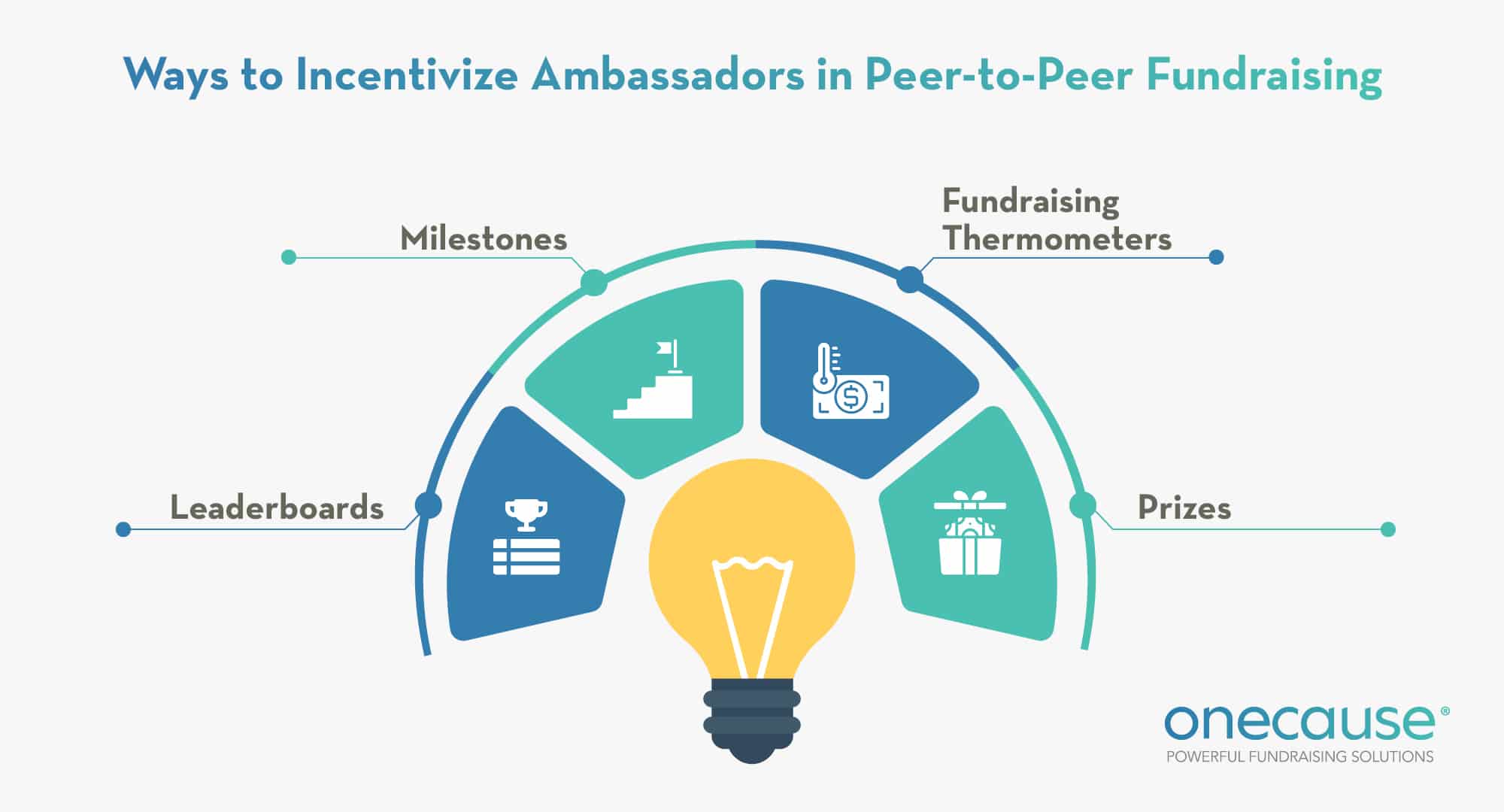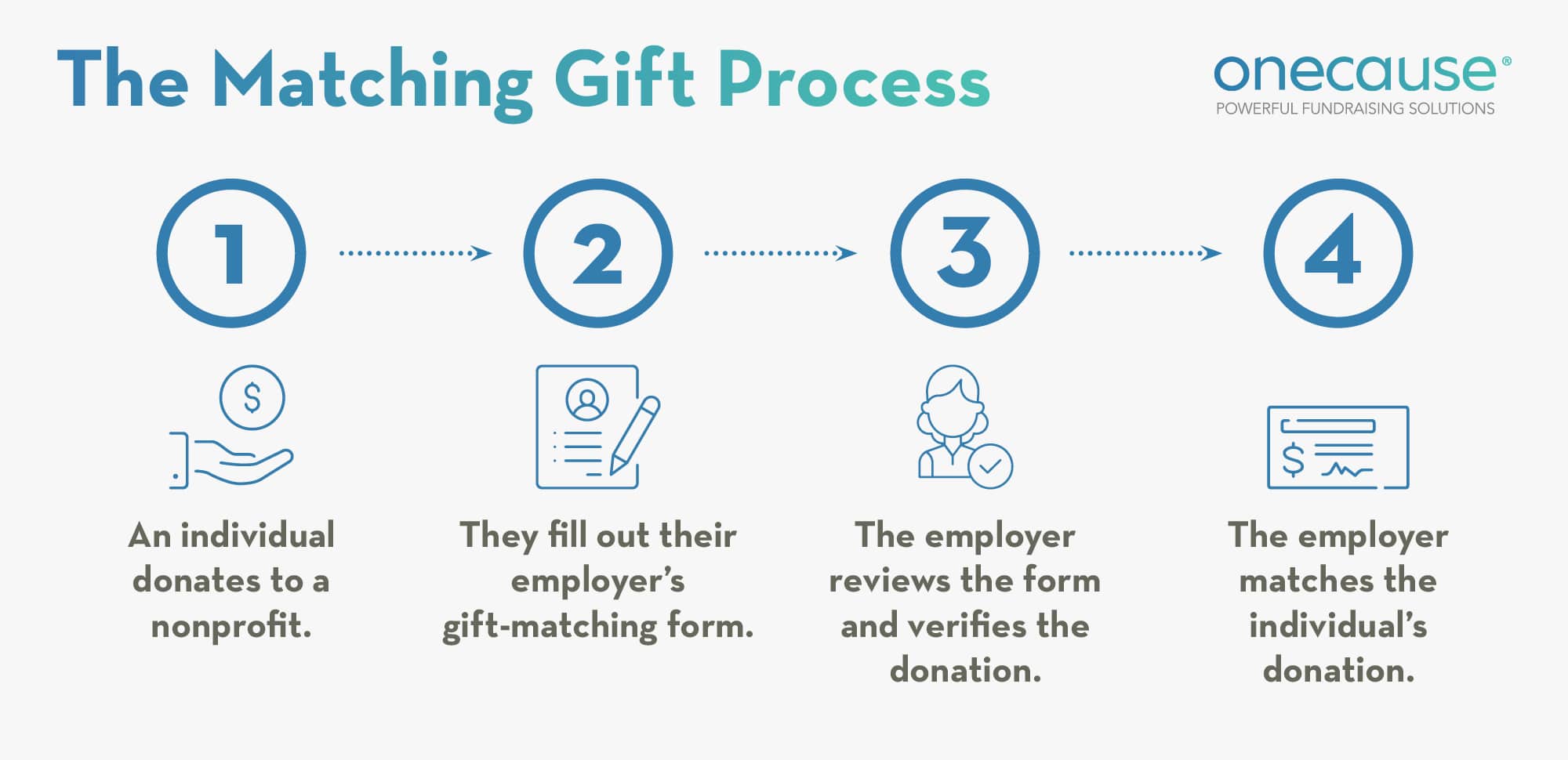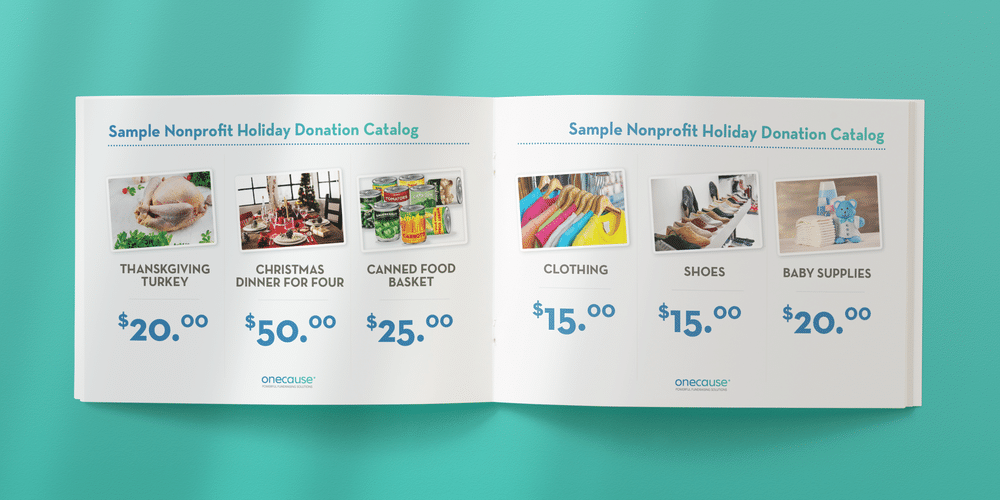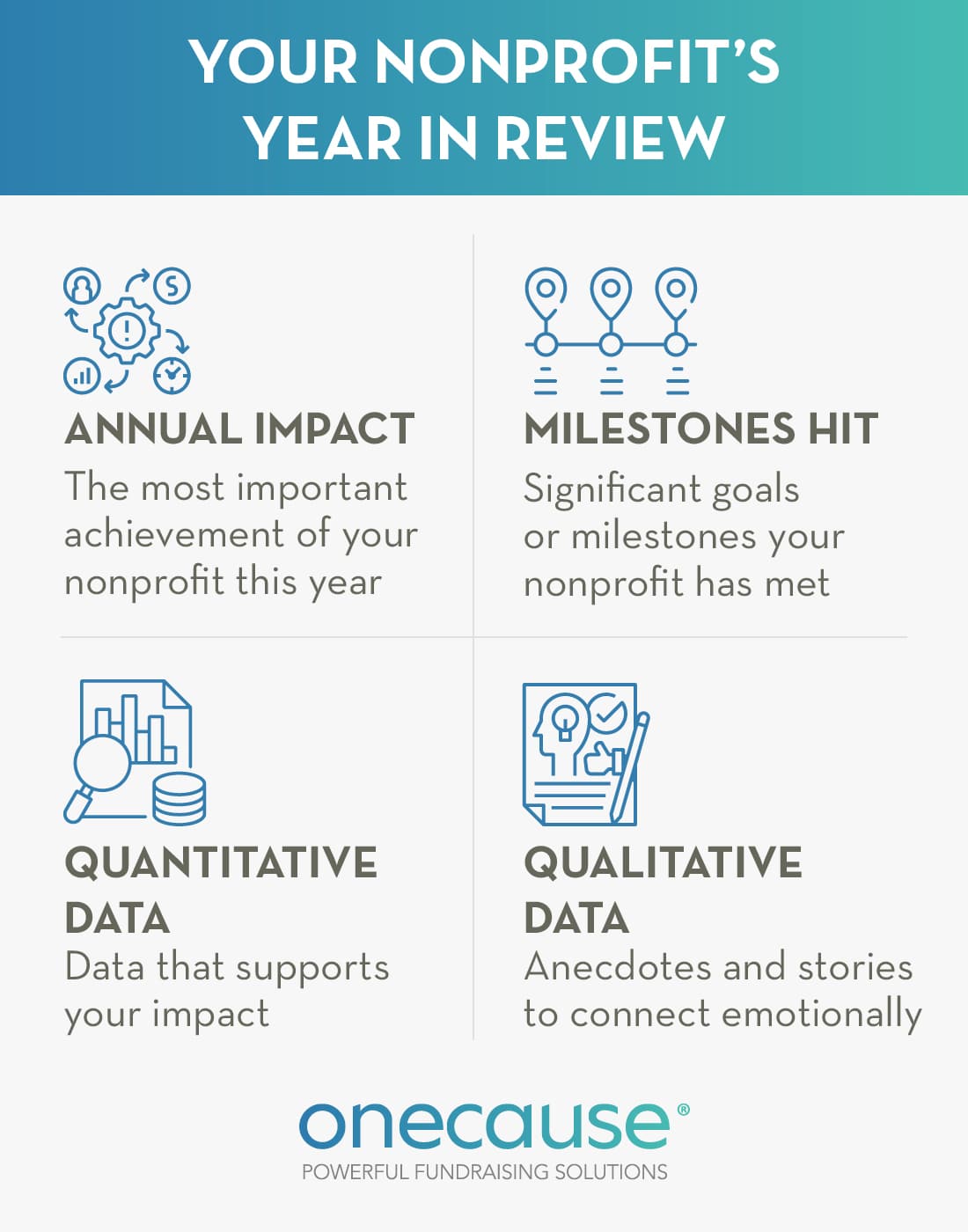10 Creative Ideas For Nonprofit Year-End Giving Campaigns
Did you know that 50% of nonprofits receive most of their annual donations in the last three months of the year? It’s no wonder that year-end is a busy time for fundraisers!
Charitable organizations prepare well in advance of the year-end fundraising season to leverage enhanced generosity, sometimes even starting their campaign and event planning in the summer.
With so many worthy causes fighting for donor attention, it’s difficult to know how to make your mission stand out. But don’t worry—we’ve seen thousands of strategies succeed and want to pass along some of the top ideas inspired by our customers. Here are 10 creative year-end giving campaigns your organization can use to raise more for your cause:
- Peer-to-Peer Fundraising
- Social Media Campaigns
- Gratitude Challenge
- Matching Gift Campaigns
- Holiday Donation Catalog
- Recurring Giving Program
- Legacy Giving Society
- Giving Tuesday Campaigns
- Year-in-Review
- Year-End Celebration Event
With these ideas, you’ll end the year strong and be well-prepared to push your cause forward next year.
1. Peer-to-Peer Fundraising for End-of-Year Giving
Year-end is a great time for you to engage core supporters and inspire them to take action on your behalf with a peer-to-peer fundraising campaign. For this year-end giving idea, supporters will create personalized online donation pages they’ll promote to their networks to raise money on behalf of your nonprofit.
For this campaign to succeed, you must enlist loyal and dedicated supporters willing to fundraise for your cause. Additionally, implement strategies to gamify the experience and incentivize ambassadors’ fundraising efforts. These might include:
- Leaderboards. Create a leaderboard where you rank ambassadors by their fundraising progress. Ambassadors will try to reach the top of the leaderboard, which will raise more funds for your nonprofit.
- Milestones. Break your fundraising campaign’s goal up into smaller milestones. Every time you get close to reaching one, send messages to your ambassadors encouraging them to help you reach it. Include marketing materials and templates they can send to their networks to boost their success.
- Fundraising thermometers. A fundraising thermometer provides a fun, interactive way of tracking how close you are to meeting your goals. Help ambassadors embed this visual into their donation pages to elicit greater generosity from their peers.
- Prizes. Incentivize ambassadors to work harder by offering prizes to the campaign’s top-performing ambassadors. For example, you might offer a gift card to the individual who received the largest amount of funds and another gift card to the individual who received the highest number of donations.
The key to a successful peer-to-peer campaign is purchasing the right software to simplify fundraising for ambassadors. Look for a peer-to-peer fundraising platform that offers personalized fundraising microsites, built-in gamification tools, event management features, and social integrations.
3. Gratitude Challenge
Although most nonprofits focus on increased giving at year-end, the last few months inspire more than generosity. With Thanksgiving and family reunions, gratefulness is also a predominant theme of the season. What better way to evoke those warm fuzzy feelings and boost fundraising for your nonprofit than with a gratitude challenge?
Encourage supporters to make donations on behalf of peers they feel grateful for. Have them write a little message alongside their donation that you’ll send to the individual the donation was made for via email or eCard. Frame this to your audience as a great opportunity for them to help that special person make an impact on your cause. Plus, you can include a call to action (CTA) in your note encouraging the recipient to share the love as well.
Take this opportunity to also show appreciation for community members who have already supported your nonprofit this year. Launch marketing materials focused on gratitude, thanking key donors, volunteers, and sponsors publicly and showcasing their impact through dedicated email newsletters, social media posts, videos, and more.
4. Year-End Matching Gift Campaigns
Matching gifts are a form of corporate philanthropy where companies match donations their employees make to eligible nonprofits. This is how it usually works:
- An individual donates to a nonprofit.
- The individual fills out their employer’s gift-matching form.
- The employer reviews the form and verifies that the donation was made.
- The employer matches the individual’s donation, usually at a 1:1 ratio.
Billions of dollars of matching gift funds go unclaimed every year, making a matching gift campaign the perfect year-end giving idea. Donors in December make 52% larger first-time gifts than donors who start giving any other time of year, and matching gifts allow you to effectively double the funds you receive. All you need to do is promote the opportunity properly and clearly outline how donors can leverage this opportunity. If you want to make the process even easier, consider working with a matching gift auto-submission tool.
Additionally, don’t overlook the power of a matching gift challenge. For this initiative, you’ll partner with a major donor or sponsor who agrees to match donations made during a set period. For example, your sponsor may match all donations made in the last week of the year at a 1:1 ratio up to $250,000. When combined with employer matching gifts, you’ll boost your fundraising to new heights!
5. Holiday Donation Catalog
Think of this fundraising idea as similar to a wedding gift registry—you’ll create a catalog of items or services beneficiaries need that donors can purchase. This year-end giving campaign is best suited for nonprofits whose beneficiaries are people. For example, an organization working to support families experiencing poverty might put the following items on their catalog:
- Thanksgiving turkey – $20
- Christmas dinner for four – $50
- Canned food basket – $25
- Clothing – $5
- Shoes – $15
- Baby supplies – $20
Nonprofits that support animals can also leverage the holiday donation catalog. Instead of the items above, they can add pet food, leashes, vaccinations, and other relevant expenses donors may want to cover.
You’ll take the funds gathered from this event and use them to purchase the corresponding items for your beneficiaries. Don’t forget to send all donors a quick summary of the items you’ve purchased through this campaign—it’s a great way of demonstrating the impact you can make.
6. Recurring Giving Program
Recurring giving has seen an explosion in popularity, and it’s no wonder why—it’s a reliable revenue stream for nonprofits that fosters loyalty among supporters and increases donor lifetime values. Monthly donors give 42% more than one-time donors annually, and recurring gifts initiated on Giving Tuesday account for 12% of the gifts made during that month.
Since donors in December generally give larger gifts than donors who start giving at other times of the year, it stands to reason that your audience may commit to higher recurring gifts. To make recurring giving accessible for your supporters, provide multiple options for gift amount and frequency. Allow donors to customize their donation size and make a gift monthly, quarterly, or annually.
7. Legacy Giving Society
Legacy giving is a type of donation where supporters create gifts for nonprofits as part of their estate plans. Usually, these gifts are not disbursed until after the donor passes away. However, because of that, individuals who make legacy gifts are more likely to make larger gifts—the average value of a bequest in 2023 was over $46,000.
Make this form of giving more enticing to supporters by establishing a dedicated legacy society and promoting it at year-end. Donors who make planned gifts will join this society and receive perks like:
- Free branded merchandise
- Access to exclusive events
- Special recognition on donor walls and installations
- Personalized gratitude messages from beneficiaries, nonprofit leaders, and board members
As you establish your legacy society, it’s also a great time to consider the types of donations your nonprofit accepts. Not everyone holds their wealth in cash, and some individuals may want to make other forms of donations, such as stocks, cryptocurrency, real estate, and more.
8. Giving Tuesday Campaigns
At the heart of year-end giving lies a single day to rule them all—Giving Tuesday. This day falls right after Cyber Monday and is the largest day for charitable giving all year. In 2023, giving on this day in the United States alone was estimated at $3.1 billion.
To make the most out of Giving Tuesday, target the right donors with the right message. Communicate your unique nonprofit value position and how Giving Tuesday donations will help grow your impact by attracting the attention of donors.
Since you only have 24 hours, make it easy for donors to give. Here are a few Giving Tuesday tips to maximize generosity:
- Giving Tuesday landing page: Include a quick summary of what Giving Tuesday is and detail your goals, how supporters can donate, key impact stories, a countdown timer, and social sharing options.
- Online fundraising tools: Leverage online fundraising tools that empower you to create online giving sites, embedded donation forms, and fundraising pages that spark generosity.
- Text-to-Give: Capture your audience’s attention through their mobile phones with Text-to-Give solutions that make it easy for them to donate on the go.
- Peer-to-peer software: Maximize social giving networks and empower loyal supporters to spread the word about your Giving Tuesday campaign with peer-to-peer tools.
Since many other nonprofits will be competing for the attention of donors on this day, be sure to establish what sets your organization apart from all others. Ask yourself: Why does your nonprofit deserve funds more than other organizations? What issue are you trying to solve urgently? Use the answers to shape your marketing strategy for your Giving Tuesday campaign.
9. Year-in-Review
A year-in-review year-end giving campaign is fairly self-explanatory—essentially, you’ll cover the impact your nonprofit has made this year and use it as a way to encourage further donations. For this campaign, create marketing materials that showcase your nonprofit’s:
- Annual impact. Highlight the most important achievement of your nonprofit this year. For example, an animal shelter might list the total number of pets they helped find forever families this year.
- Milestones hit. If your nonprofit has met any significant goals or milestones, this is also the time to mention them. For instance, an aquarium might mention that they’ve developed a new method for drawing blood from whale sharks.
- Quantitative data. Back up your impact with quantitative data to build authority and show that your nonprofit is a trustworthy organization deserving of support.
- Qualitative data. Cold, hard data isn’t enough to connect with your supporters—you should also include anecdotal evidence and stories from beneficiaries that evoke an emotional connection.
When you send out these marketing materials, encourage supporters to donate to help you meet your year-end fundraising goals. Emphasize that with their support, you can end this year strong and be set up for success in the new year.
10. Year-End Celebration Event
The end of the year is a great time to bring your community together to say thanks, have fun, and spread some year-end cheer—either in person or virtually!
Typically, year-end fundraising events are festive affairs. Whether they’re galas or online auctions, the general rule of thumb is to use these events to celebrate with your donors and thank them for all they do to support your mission. To reach as many donors as possible, it’s important to add a virtual element—let community members celebrate with you wherever they are!
Make sure you’re using the right tools to make giving seamless and easy for your supporters. Invest in robust fundraising event software that offers all the features you need, regardless of if your event is in-person, hybrid, or virtual.
Preparing for Year-End Giving Campaigns
Although year-end giving campaigns take place in the last three months of the year, begin preparing for them well in advance to give yourself ample time. Start the planning process in early summer so that you’re ready to hit the ground running in October!
If you want to learn more about nonprofit fundraising, check out these resources:
- The Ultimate Guide to Year-End Giving for Nonprofits. Explore best practices for year-end giving to boost results for your nonprofit.
- Top Online Fundraising Ideas to Capture Donors’ Attention. Want to take your fundraising online? Discover the top ideas for online campaigns here.
- Top 10 Nonprofit Fundraising Platforms to Explore. No fundraising campaign is complete without the right software to streamline the process. Take a look at our recommended platforms in this guide.








2. Year-End Social Media Campaigns
Running a fun year-end or holiday-themed social media campaign is another way to creatively wade through the busy giving season. These types of campaigns engage active donors and attract new supporters to help you reach your goals.
Follow our top tips to get the most from your year-end social media campaign:
Keep in mind the power of video. By utilizing videos on social media, the visual messaging combined with the power and reach of social media makes for a powerful end-of-year message. These videos can be short and don’t need to be professional (in fact, videos taken on a phone work just fine).